Rietveld Academie, Amsterdam
Art academy in The Netherlands
Piezography
size: 173 x 120 cm / 68” x 47”
year: 2018
In this picture we see the workspaces of the Fine Art Department at the Gerrit Rietveld Academie in Amsterdam. The studios are located in a huge warehouse. Katrin and Jens were fascinated by the way the space was divided; every student has their own tiny workroom that they can use to experiment and explore. The structure of the space reminded them of the architecture of art fairs. Another notable aspect is the different kinds of materials the students use. These details reveal the bustling creativity of the students and the organised chaos that is so typical of an art school.
The series Back Stages was created in collaboration with Jens Pfeifer
We are presenting a visual manifest of the artistic and cultural creation process by emphasizing values placed on the production and handling of artistic goods. Our manifest takes place in local, global and digital contexts. We are fascinated by systems of manufacture for art and culture as opposed to the romantic notion of the artist laboring in solitude within their studio. Here, places and objects compose and materialize cultural identity. Artistic meaning is not only found in a finished artwork. From planning to execution, it is embodied in every stage of the fabrication process. These works investigate how cultural traditions can be expressed in the different processes of making, collecting and preserving. The evolution of industry in the 21st century is changing radically. We intend to have a closer look at the labor of art, culture and crafts as well as the understanding and value of these definitions in different local cultures and global contexts.
THE BOOK
Hui'an
Granite sculpture workshop in China
Piezography
size: 150 x 960 cm l 60” x 380” 35 x 225 cm l 14” x 87”
year: 2015
The city of Hui'an, in the province of Fujian in southeast China, has a long history of mining and sculpting granite. Katrin and Jens found themselves in a region that is dominated by stone-carving factories, where sculptures of various kinds are lined up along the streets. Artists from all over the world have their work manufactured here and shipped overseas to their final destinations in museums or galleries. The workshops manufacture anything from modern abstract sculptures to kitschy decorations. A layer of fine granite dust covers the streets and enters the houses. Stone carving is a very labour-intensive and even dangerous profession with the loud noises of hammering constantly in the background. Although the Hui'an Chinese officially belong to the Han nationality, many aspects of their culture are unique among the people of China. In this picture, you can see some women wearing specific hats and scarves that are part of the traditional regional costume. These costumes have attracted the attention of both anthropologists and governmental censorship. The clothes give the wearer a regional identity, something that has largely been banned throughout the country. In the 20th century, most of the strenuous carving was done by female workers while the men were either fishing at sea or fighting in wars.
The series Back Stages was created in collaboration with Jens Pfeifer
We are presenting a visual manifest of the artistic and cultural creation process by emphasizing values placed on the production and handling of artistic goods. Our manifest takes place in local, global and digital contexts. We are fascinated by systems of manufacture for art and culture as opposed to the romantic notion of the artist laboring in solitude within their studio. Here, places and objects compose and materialize cultural identity. Artistic meaning is not only found in a finished artwork. From planning to execution, it is embodied in every stage of the fabrication process. These works investigate how cultural traditions can be expressed in the different processes of making, collecting and preserving. The evolution of industry in the 21st century is changing radically. We intend to have a closer look at the labor of art, culture and crafts as well as the understanding and value of these definitions in different local cultures and global contexts.
THE BOOK
Back Stages Glass, Anxi
Glass factory in China
Piezography
size: 150 x 216 cm l 59” x 85” 120 x 173 cm l 47” x 68”
year: 2017
This glass factory in Anxi, southern Fujian province, is a family business that mainly produces hand-made mould-blown glass. The facilities in the factory are very basic. It is situated on a hill outside a small village, with one large furnaceand a shabby roof covering the workspace. The batch for making the glass is piled up in large bags all over the work floor. It's a pretty chaotic place; the heat from the furnace is intense, as is the sound from the fans that are used in an attempt to cool the space. Because the factory uses coal to fire the kilns, the floor is pitch black. The unhealthy environment of the factory is in stark contrast with the shiny blue, emerald and crystal-like glass it produces. Small workshops like this come and go,bound as they are to the changes of an unpredictable economy.
The series Back Stages was created in collaboration with Jens Pfeifer
We are presenting a visual manifest of the artistic and cultural creation process by emphasizing values placed on the production and handling of artistic goods. Our manifest takes place in local, global and digital contexts. We are fascinated by systems of manufacture for art and culture as opposed to the romantic notion of the artist laboring in solitude within their studio. Here, places and objects compose and materialize cultural identity. Artistic meaning is not only found in a finished artwork. From planning to execution, it is embodied in every stage of the fabrication process. These works investigate how cultural traditions can be expressed in the different processes of making, collecting and preserving. The evolution of industry in the 21st century is changing radically. We intend to have a closer look at the labor of art, culture and crafts as well as the understanding and value of these definitions in different local cultures and global contexts.
THE BOOK
Back Stages Teylers, Haarlem
18th-century museum for the arts and sciences in The Netherlands
Piezography
size: 300 x 430 cm l 118” x 170” 120 x 173 cm l 47” x 68”
year: 2017
Founded in 1784, the Teylers Museum is the first and oldest museum in the Netherlands. It is a museum for both art and science that displays artistic endeavours like paintings alongside scientific objects and paraphernalia. The long vitrine in the middle of the picture is unique and typical for the museum. The museum even has several fake artefacts on exhibit, a prank that malicious colleagues pulled on the collector and amateur-archaeologist Johann Beringer. As the picture is quite large you can see all the details of the fossils and skeletons. The vitrines, the objects, and the floor are all in black and white while the visitors are portrayed in colour. This is to emphasise the contrast between the history of the museum and the dynamics of the people present. This work is an interpretation of a classic display that shows the collecting and archiving of artefacts. It elucidates that art, or the perception of art, is not exclusively reserved for the process of conceiving or making but still happens in the 'afterlife' of objects.
The series Back Stages was created in collaboration with Jens Pfeifer
We are presenting a visual manifest of the artistic and cultural creation process by emphasizing values placed on the production and handling of artistic goods. Our manifest takes place in local, global and digital contexts. We are fascinated by systems of manufacture for art and culture as opposed to the romantic notion of the artist laboring in solitude within their studio. Here, places and objects compose and materialize cultural identity. Artistic meaning is not only found in a finished artwork. From planning to execution, it is embodied in every stage of the fabrication process. These works investigate how cultural traditions can be expressed in the different processes of making, collecting and preserving. The evolution of industry in the 21st century is changing radically. We intend to have a closer look at the labor of art, culture and crafts as well as the understanding and value of these definitions in different local cultures and global contexts.
THE BOOK
Back Stages Chouara, Fes
Cooperative 11th-century tannery in Morocco
Piezography
size: 120 x 173 cm 47” x 68”
year: 2018
Family run cooperatives have been tanning leather in Chouara for the best part of 1000 years. Located in the old town of Fez and still fully functioning, this ancient industry has become a popular tourist destination. The basins depicted are filled with the dyes used by the workers and although the site and its surroundings are beautiful, the smells coming from it are repugnant. The reason for the strong odour is the pigeon droppings that are being used to unhair the hides. The basins in which the skins are dyed are quite large, with some pots measuring 1.50 meters in diameter. Once a week, all the dyes in the pots are renewed and the colour combinations are constantly changing. All the colours are made with natural materials such as poppy seeds and saffron. The tannery has been an independent selfsufficient business for hundreds of years, that also includes the many shops surrounding it.
The series Back Stages was created in collaboration with Jens Pfeifer
We are presenting a visual manifest of the artistic and cultural creation process by emphasizing values placed on the production and handling of artistic goods. Our manifest takes place in local, global and digital contexts. We are fascinated by systems of manufacture for art and culture as opposed to the romantic notion of the artist laboring in solitude within their studio. Here, places and objects compose and materialize cultural identity. Artistic meaning is not only found in a finished artwork. From planning to execution, it is embodied in every stage of the fabrication process. These works investigate how cultural traditions can be expressed in the different processes of making, collecting and preserving. The evolution of industry in the 21st century is changing radically. We intend to have a closer look at the labor of art, culture and crafts as well as the understanding and value of these definitions in different local cultures and global contexts.
THE BOOK

Marble, Carrara
Marble production company in Italy
Piezography
size: 216 x 150 cm l 85" x 59" 120 x 173 cm l 47" x 68"
year: 2017
Carrara, in the northwest of Tuscany, Italy, is a city that is famous for its marble production.
Since Roman times, Carrara has been the heart of the world's marble production, making the
quarries one of the oldest industrial areas still in use. Even the one where Michelangelo chose the marble for his famous Pièta is still in use. The mountains in Carrera host about 600 marble quarries. In addition there are multiple marble museums and marble workspaces. This picture shows small traces of the region's grand history. In the far-left corner, the feet of a David replica are visible. One of the workers wears a hat folded from a newspaper, a typical costume feature worn by craftsmen from Carrara. Everything in the workspace is covered in fine white marble dust, merging the image into a monochrome tableau.
The series Back Stages was created in collaboration with Jens Pfeifer
We are presenting a visual manifest of the artistic and cultural creation process by emphasizing values placed on the production and handling of artistic goods. Our manifest takes place in local, global and digital contexts. We are fascinated by systems of manufacture for art and culture as opposed to the romantic notion of the artist laboring in solitude within their studio. Here, places and objects compose and materialize cultural identity. Artistic meaning is not only found in a finished artwork. From planning to execution, it is embodied in every stage of the fabrication process. These works investigate how cultural traditions can be expressed in the different processes of making, collecting and preserving. The evolution of industry in the 21st century is changing radically. We intend to have a closer look at the labor of art, culture and crafts as well as the understanding and value of these definitions in different local cultures and global contexts.
THE BOOK

Back Stages Ballet rehearsal, Amsterdam
Rehearsal of the National Ballet, The Netherlands
Piezography
size: 145 x 100cm l 57” x 39”
year: 2018
In Amsterdam, a rehearsal for the ballet piece Sleeping Beauty by the Dutch National Ballet is in full swing: from the stretching on the ground, to the exercises at the barre and finally the elegant poses and pirouettes of the corps and solo dancers. A ballet shoe is being laced, jackets and long trousers are being taken off and costumes are zipped up. There is a certain crescendo within the process of shedding layers of clothes as part of the dynamics and rhythm of the rehearsal. In the picture, you can feel the movement of the dancers, but it is not yet fully coordinated. The lines and dots on the floor are codes that tell the dancers how and where to move. Some props that are used in the show, like flowers, are also part of the rehearsal scene. The practice and repetition of the dance until perfection are part of a production process. Despite the cleanliness and the assumed fragility, it is the hard physical labour that makes this workplace so fascinating.
The series Back Stages was created in collaboration with Jens Pfeifer
We are presenting a visual manifest of the artistic and cultural creation process by emphasizing values placed on the production and handling of artistic goods. Our manifest takes place in local, global and digital contexts. We are fascinated by systems of manufacture for art and culture as opposed to the romantic notion of the artist laboring in solitude within their studio. Here, places and objects compose and materialize cultural identity. Artistic meaning is not only found in a finished artwork. From planning to execution, it is embodied in every stage of the fabrication process. These works investigate how cultural traditions can be expressed in the different processes of making, collecting and preserving. The evolution of industry in the 21st century is changing radically. We intend to have a closer look at the labor of art, culture and crafts as well as the understanding and value of these definitions in different local cultures and global contexts.
THE BOOK

Nijhof Beeldenstorm, Brabant
Collaborative artists Bronze art foundry in The Netherlands
Piezography
size: 120 x 173 cm 47" x 68"
year: 2017
This picture is a combination of two bronze art foundries in the Netherlands: De Smelterij in Veen and Beeldenstorm in Eindhoven. The latter is an open workspace where artists can work with different materials and techniques supported by a team of dedicated specialists. The former is a traditional family business, run by Hans and Marion Nijhof, that offers the full service of bronze casting; from mould making to patinated finishes. Katrin and Jens decided to merge images of the two companies into one picture to create a fragmented space that makes the process of bronze and aluminium casting appealing.
The series Back Stages was created in collaboration with Jens Pfeifer
We are presenting a visual manifest of the artistic and cultural creation process by emphasizing values placed on the production and handling of artistic goods. Our manifest takes place in local, global and digital contexts. We are fascinated by systems of manufacture for art and culture as opposed to the romantic notion of the artist laboring in solitude within their studio. Here, places and objects compose and materialize cultural identity. Artistic meaning is not only found in a finished artwork. From planning to execution, it is embodied in every stage of the fabrication process. These works investigate how cultural traditions can be expressed in the different processes of making, collecting and preserving. The evolution of industry in the 21st century is changing radically. We intend to have a closer look at the labor of art, culture and crafts as well as the understanding and value of these definitions in different local cultures and global contexts.
THE BOOK
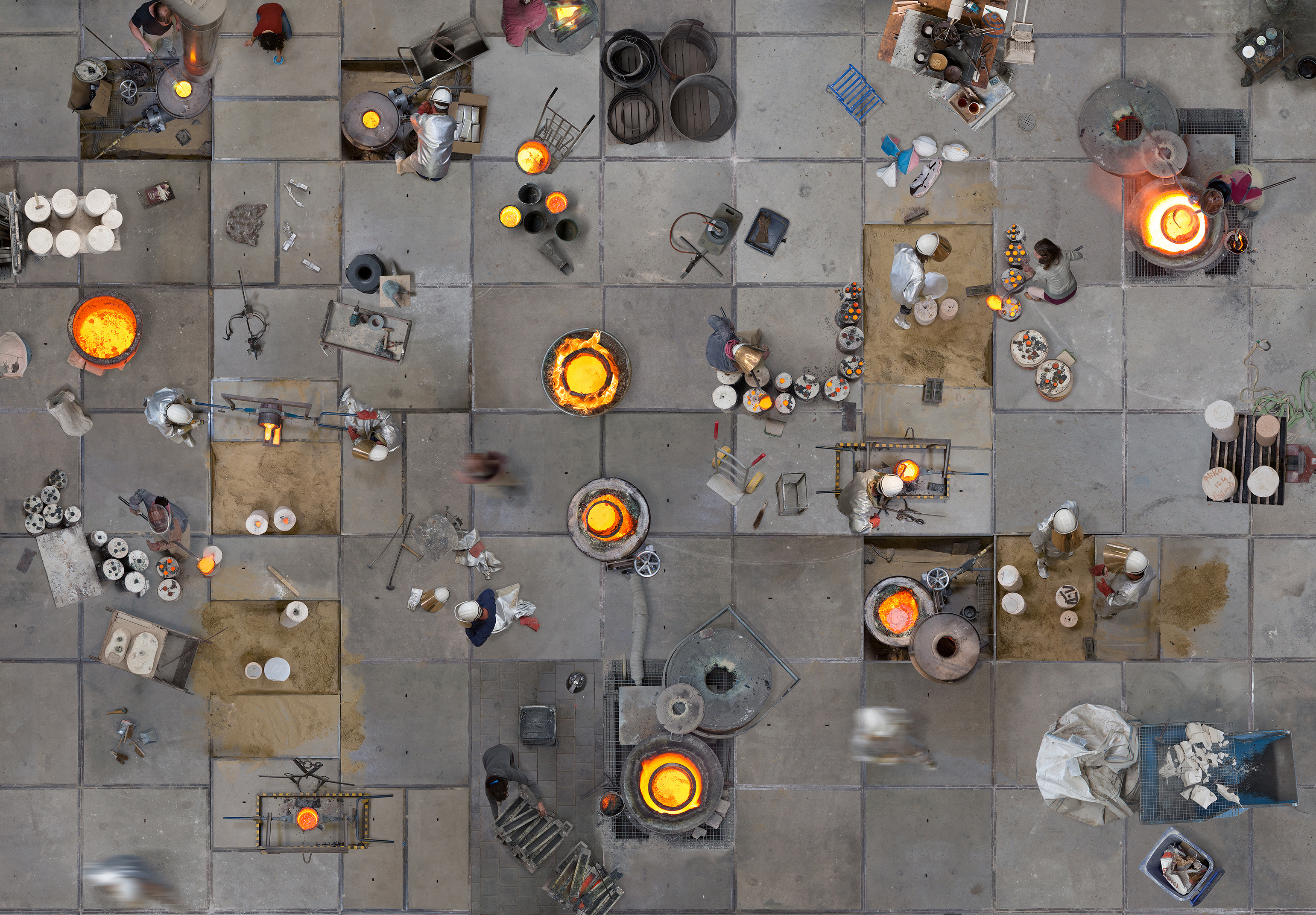
Back Stages Stainless Steel, Xiamen
Stainless steel fabrication workshop for sculpture in China
Piezography
size: 120 x 173 cm 47" x 68"
year: 2017
The stainless steel fabrication workshop in Xiamen, China is an enormous chaos where materials slither across the ground like snakes. A huge steel globe shines as if it is already finished, while a steel lotus flower, situated to the left, is wrapped in plastic, awaiting a final touch. Jens had a small series of sculptures made in this workshop. This was one of the first pictures that Katrin and Jens created for Back Stages. Fascinated by the turmoil of the place and the intensity of the labour process they decided to start this series. Arguably, this fabrication workshop could be considered a sweatshop for art production. But this is a highly specialised craft and the artisans use specific techniques of hammering and polishing that take years to learn. The likes of these techniques cannot be found in Europe and even in China it is a dwindling skill
Therefore, workers have to be recruited from all over the country.
The series Back Stages was created in collaboration with Jens Pfeifer
We are presenting a visual manifest of the artistic and cultural creation process by emphasizing values placed on the production and handling of artistic goods. Our manifest takes place in local, global and digital contexts. We are fascinated by systems of manufacture for art and culture as opposed to the romantic notion of the artist laboring in solitude within their studio. Here, places and objects compose and materialize cultural identity. Artistic meaning is not only found in a finished artwork. From planning to execution, it is embodied in every stage of the fabrication process. These works investigate how cultural traditions can be expressed in the different processes of making, collecting and preserving. The evolution of industry in the 21st century is changing radically. We intend to have a closer look at the labor of art, culture and crafts as well as the understanding and value of these definitions in different local cultures and global contexts.
THE BOOK
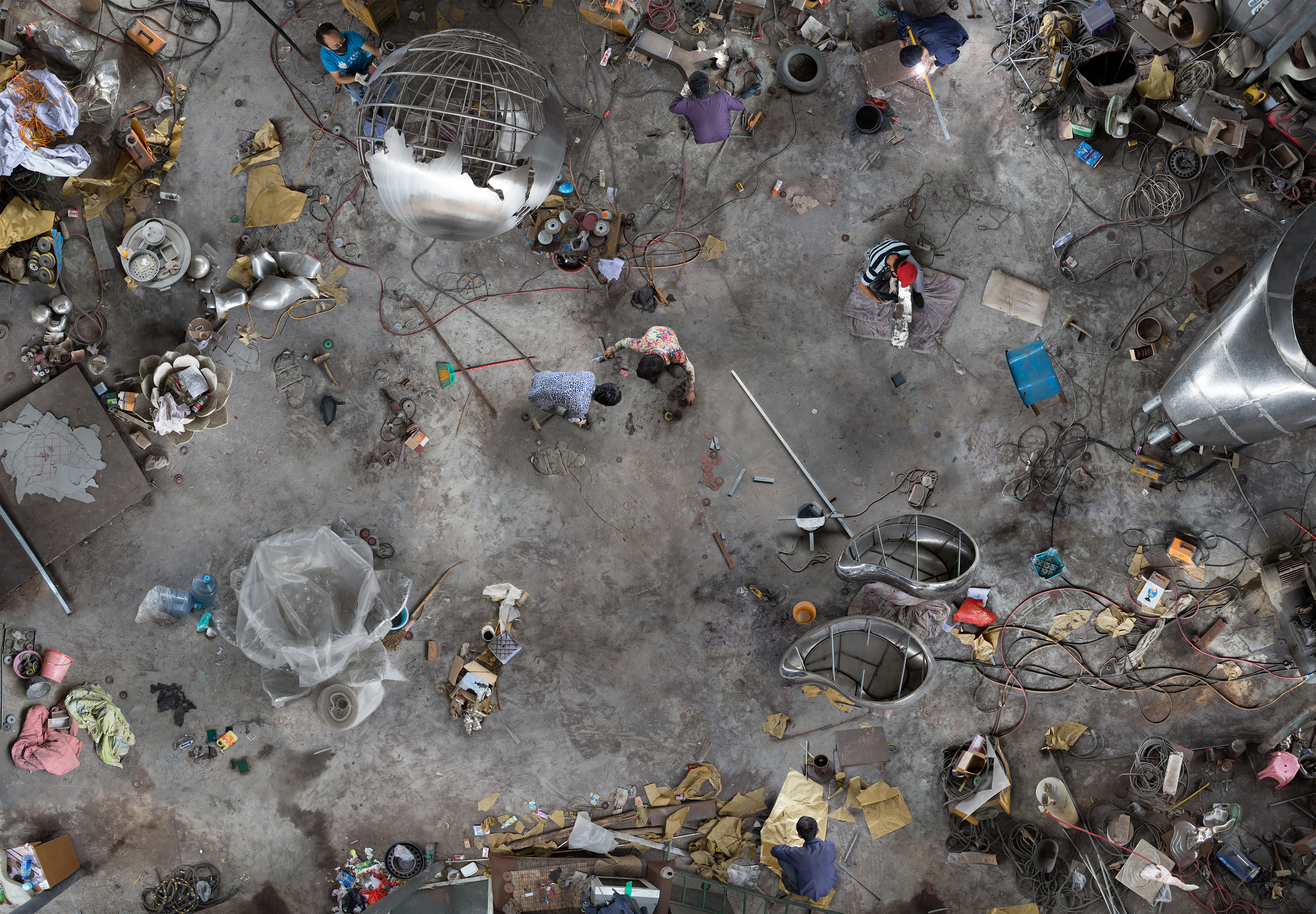
Back Stages Troy
Archeological excavation in Troy, Turkey
Piezography
size: 350 x 243 cm l 138” x 96” 173 x 120 cm l 68” x 47”
year: 2018
In Troy, the culture lies hidden in the earth, layered during centuries and re-cultivated through archaeological excavation. Troy is a mythical place, full of history and shrouded in mystery. The identity of Troy oscillates between epic tale and historical fact. Even today it is still unclear if the war and the famous ploy with the Trojan horse ever really happened. However, Homer's epic has become part of our cultural identity. The image shows only a small part of the huge and multiple-layered excavation site. It just looks like a large surface with stones where people are working and digging in the hot sun. Very much like the Trojan myth, it is unclear what kind of history has actually taken place in this dry and sandy landscape. The culture is hidden in and under numerous layers of sand and stone and can only be revealed by excavation. Creating this picture was a personal trip for Katrin as her uncle, the highly respected archaeologist M. Osman Korfmann who passed away in 2005 , dedicated his whole life to researching Troy.
The series Back Stages was created in collaboration with Jens Pfeifer
We are presenting a visual manifest of the artistic and cultural creation process by emphasizing values placed on the production and handling of artistic goods. Our manifest takes place in local, global and digital contexts. We are fascinated by systems of manufacture for art and culture as opposed to the romantic notion of the artist laboring in solitude within their studio. Here, places and objects compose and materialize cultural identity. Artistic meaning is not only found in a finished artwork. From planning to execution, it is embodied in every stage of the fabrication process. These works investigate how cultural traditions can be expressed in the different processes of making, collecting and preserving. The evolution of industry in the 21st century is changing radically. We intend to have a closer look at the labor of art, culture and crafts as well as the understanding and value of these definitions in different local cultures and global contexts.
THE BOOK
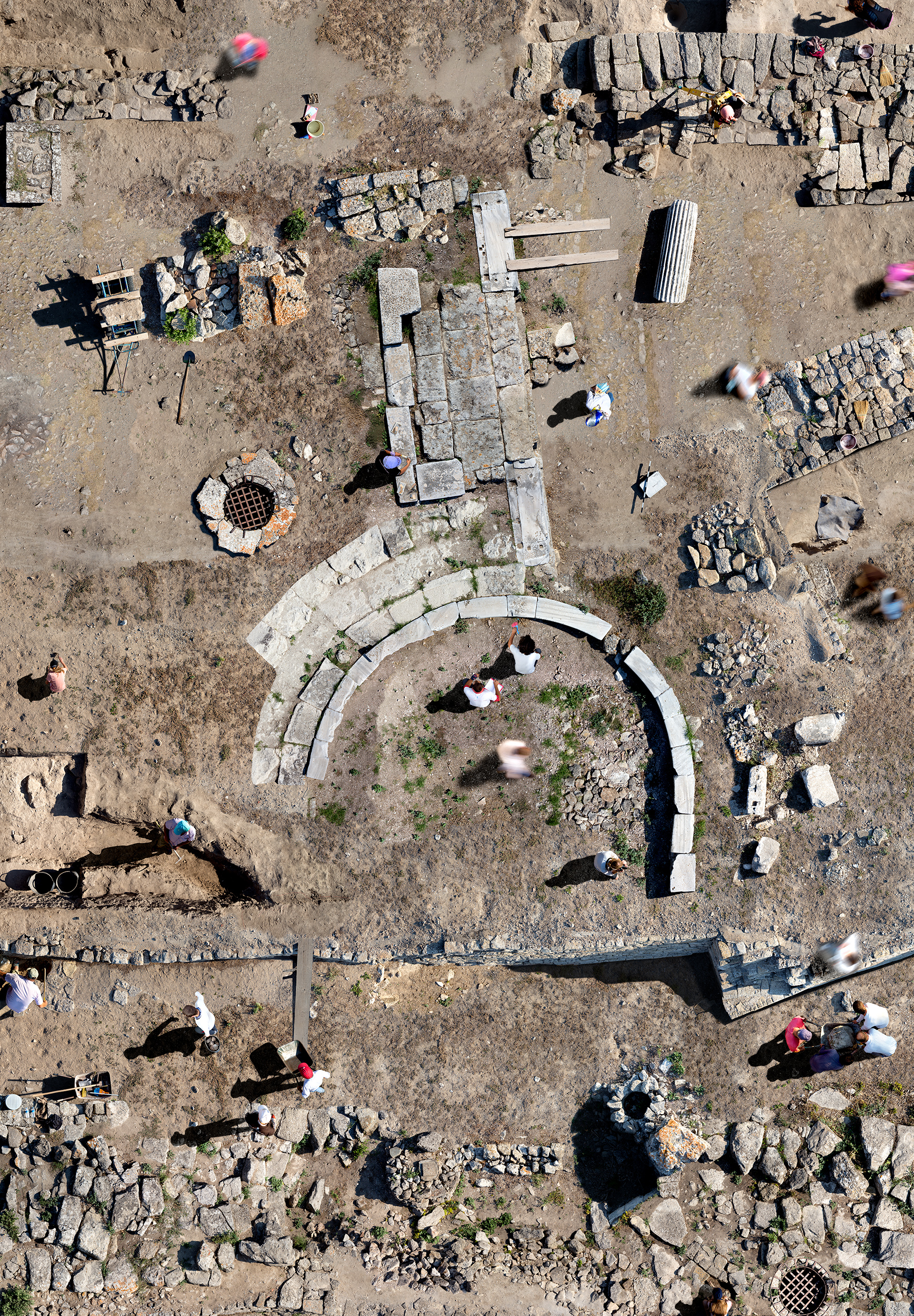
Installation view
38CC, Delft
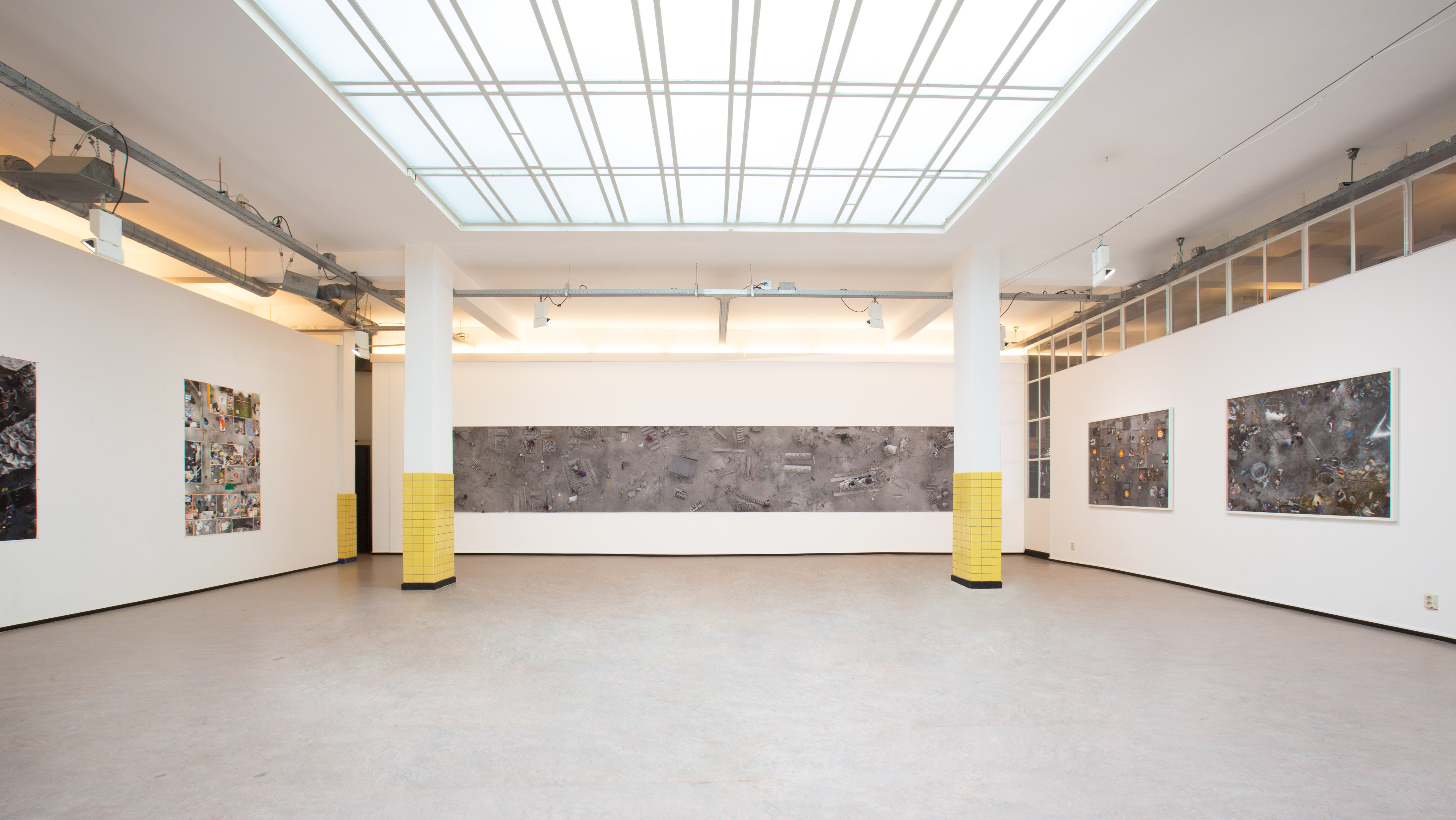
Back Stages Bildhauer Werkstatt, Berlin
Collaborative artists studio space in Germany
Piezography
size: 145 x 100 cm 57” x 39 “
year: 2018
The Bildhauerwerkstatt in Berlin is a place where artists can rent a workshop and create with materialslike metal, wood, stone, ceramics, plaster and plastic. It is situated in a hidden romantic industrial monument next to a little river in the neighbourhood of Wedding. The surface of the Werkstatt is 3600m2 in total with ceilings as high as 12 meters. Because the space is supported by the city, rent is affordable. There are not many open studios like this in Berlin and Bildhauerwerkstatt is very popular and busy. The wellequipped workshops with their cooperative ambiance draw professional artists and amateurs alike and are purely designed to support the process of making. There is no room for presentations or exhibitions.
The series Back Stages was created in collaboration with Jens Pfeifer
We are presenting a visual manifest of the artistic and cultural creation process by emphasizing values placed on the production and handling of artistic goods. Our manifest takes place in local, global and digital contexts. We are fascinated by systems of manufacture for art and culture as opposed to the romantic notion of the artist laboring in solitude within their studio. Here, places and objects compose and materialize cultural identity. Artistic meaning is not only found in a finished artwork. From planning to execution, it is embodied in every stage of the fabrication process. These works investigate how cultural traditions can be expressed in the different processes of making, collecting and preserving. The evolution of industry in the 21st century is changing radically. We intend to have a closer look at the labor of art, culture and crafts as well as the understanding and value of these definitions in different local cultures and global contexts.
THE BOOK
superzoom

Installation view
International Canakkale Biennial, Turkey
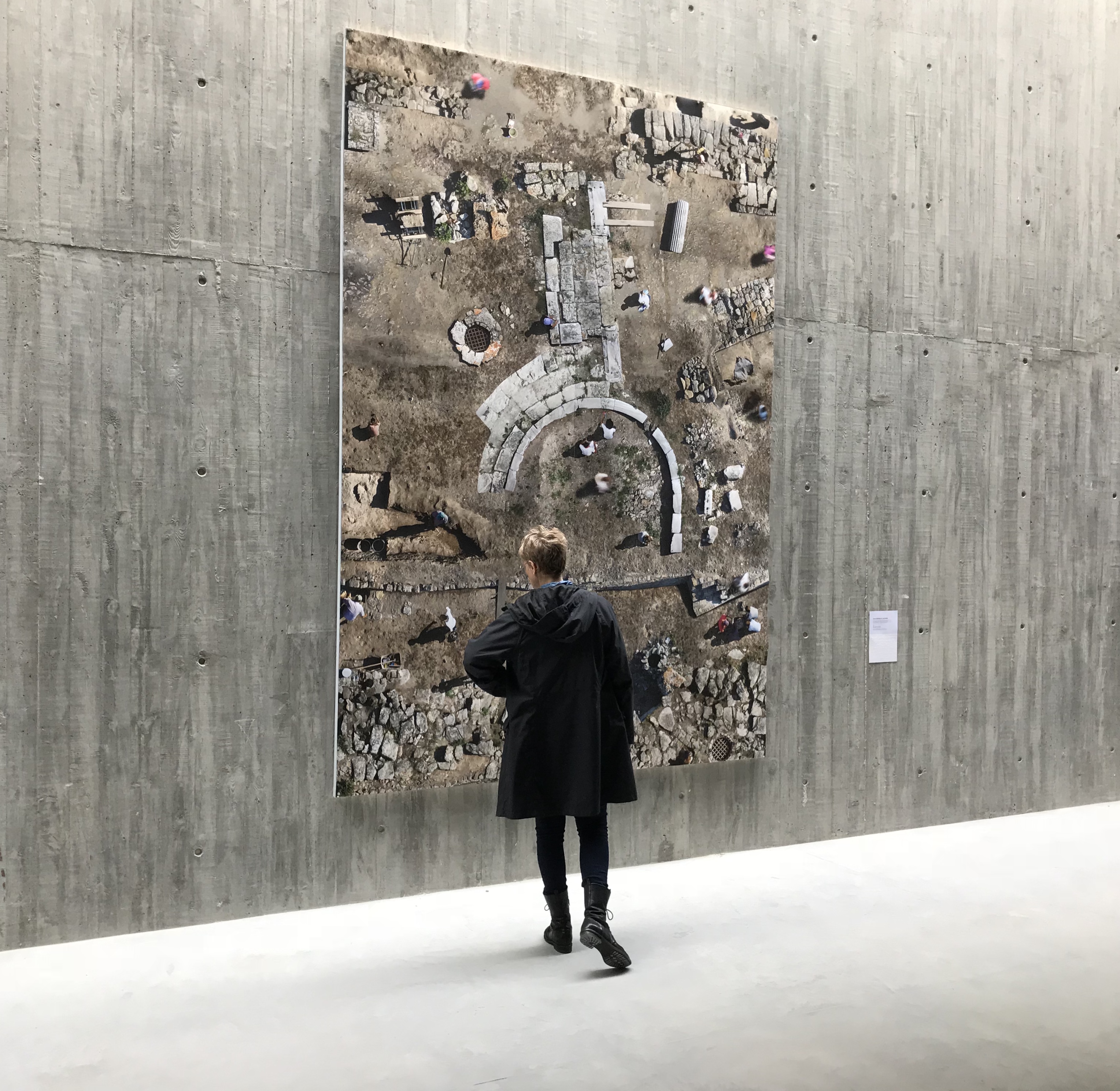
Installation view
Big Art Amsterdam
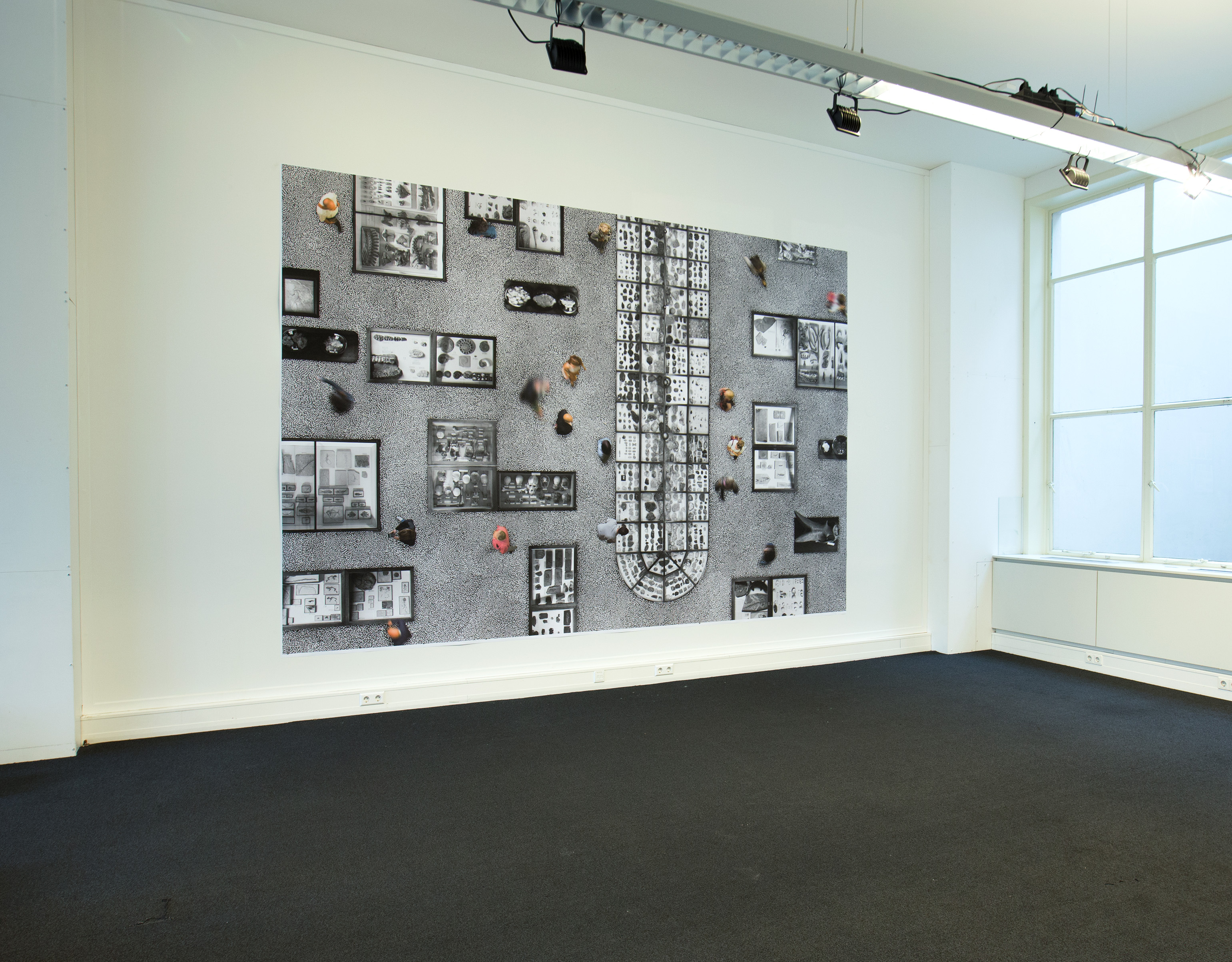
Verzamelaarsjaarbeurs
Collectors Fair in Utrecht, the Netherlands
Piezography
size: 173 × 120 cm l 68" × 47"
year: 2019
Twice a year, people present and sell their collections of beloved objects here. The merchandise ranges from displayed ceramic and glass collections to more kitschy items like dozens of cuddly toys carefully arranged on a table, as if they were exhibits in a museum. Back Stages eventually refers to the border of art, kitsch and design, and these themes are stressed in the image of the Verzamelaars-Jaarbeurs. The objects we call kitsch may well be art in other countries. You can actually find many fascinating and valuable items at the fair. But its true worth is in the wonderful variety of the kinds of objects people cherish and find interesting enough to collect, show and share with others.
The series Back Stages was created in collaboration with Jens Pfeifer
We are presenting a visual manifest of the artistic and cultural creation process by emphasizing values placed on the production and handling of artistic goods. Our manifest takes place in local, global and digital contexts. We are fascinated by systems of manufacture for art and culture as opposed to the romantic notion of the artist laboring in solitude within their studio. Here, places and objects compose and materialize cultural identity. Artistic meaning is not only found in a finished artwork. From planning to execution, it is embodied in every stage of the fabrication process. These works investigate how cultural traditions can be expressed in the different processes of making, collecting and preserving. The evolution of industry in the 21st century is changing radically. We intend to have a closer look at the labor of art, culture and crafts as well as the understanding and value of these definitions in different local cultures and global contexts.
THE BOOK
